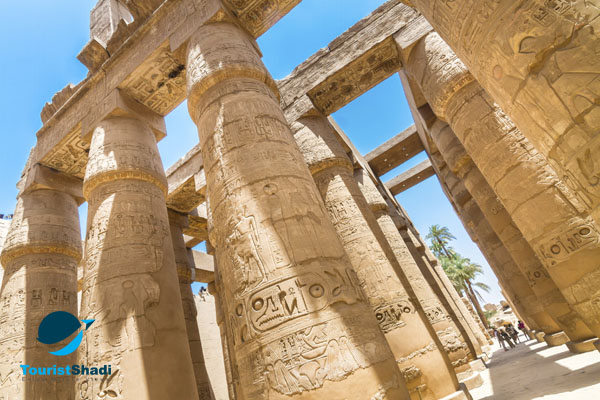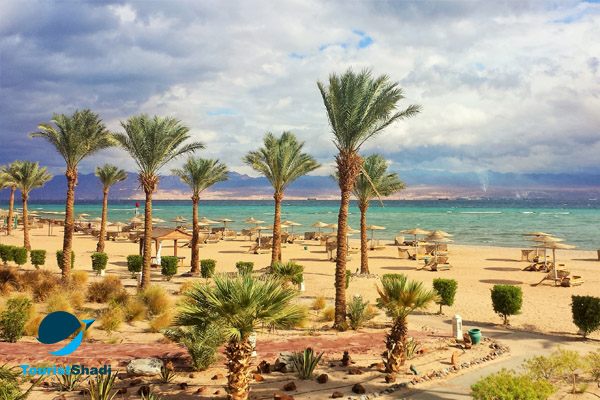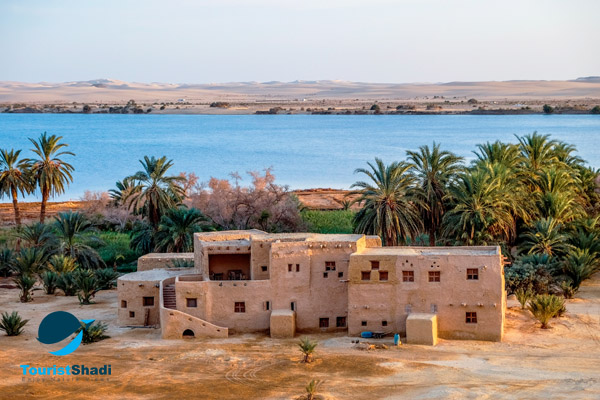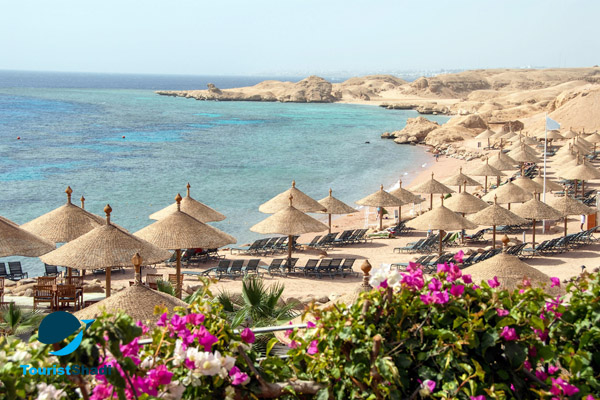Alexandria:
Established by Alexander the Macedonian, Known as the Mediterranean Bride. Many kings ruled this city, and famous for the beauty beaches and warm atmosphere. When you visit you will find the beauty of the blue beach, the splendor of the sunset, and you can see the historical relics while enjoying the beauty of the blue sea like Qaitbay Castle, where there are many monuments and historical places worth visiting.
You will also notice the diversity of tourism from its historical, cultural, recreational, and other. Numerous accommodations, restaurants to suit all tastes of tourists.
Popular Tourism Sights:
- Alexandria Library:

It is the newest tourist attraction built in Alexandria, featuring by its location near the beach and its innovative geometric construction in the form of a sun.
Comparable to the world libraries of books abundance, and large area. During your tour in the library, you will find a variety of cultural activities. There are several libraries and centers such as the Library of the Blind, and the Center of the archive of electronic browsing.
You will find a range of monuments during your enjoyable journey inside the library such as Greek, Roman, statues and others.

- Alexandria National Museum:
The museum is one of the places that you should visit during your stay in this beautiful city. An old map will help you understand the development of the city during successive eras. You will also enjoy the many varied monuments of ancient statues and relics that come back to different civilizations such as the Pharaonic era, Roman, Byzantine, Islamic, until it reaches the present age. Where the museum houses a large collection of history of the Mediterranean bride.
- Qaitbay Castle:
 The castle is one of the places that we recommend to visit; it was a wonder in its time and built in the Mameluke era to protect the city from the dangers that beset it.
The castle is one of the places that we recommend to visit; it was a wonder in its time and built in the Mameluke era to protect the city from the dangers that beset it.
When you visit the castle, you will notice internal walls where there are places for soldiers and weapons stores, and external walls with towers to throw arrows and on the upper floor of the castle, ships seen a day before arrival, as there was a place to prepare the soldiers’ food.
The site of the strategic castle paid royalty to its attention, developed, restored over time.
- Royal Jewelry Museum:
 Also called the Jewelry Palace, because it contains the jewelry of royal families that ruled Egypt until the 1952 revolution, where the contents of the palace were confiscated and turned into a museum in 1986.
Also called the Jewelry Palace, because it contains the jewelry of royal families that ruled Egypt until the 1952 revolution, where the contents of the palace were confiscated and turned into a museum in 1986.
While touring the museum, you will see a huge amount of jewelry, gold, combining different collections of jewelry including:
• A group belonging to the founder of the Alawite family, including a box of gold-plated enamel called “Mohammed Ali”
• Prince Mohammed Ali Tewfik Group
• Collection of scarves and gold watches of the era
• Watches of gold and colored enamel images of Khedive Ismael and Khedive Tawfiq.
• King Fouad monuments & jewelry Group, the most important: gold handle with diamonds, gold medals with his photo on it.

- Tombs of Kom Al-Shakfa:
This cemetery is important because of the abundance of the place and the abundance of decorations and the complexity of planning, and is a clear example of the integration of Pharaonic art with Roman art in the city and represent the finest models of funerary architecture.
The construction of tombs is as follows:
The entrance is above the ground, followed by a spiral staircase leading to the first ground floor. It consists of a vestibule connected to a round hall, adjoining a spacious rectangular hall with three sofas, the dining hall. At the end of the round hall there is a staircase leading to the second ground floor, the floor where the main part of the burial is located in the cemetery, and then we reach the third floor and are now flooded.
- Pillar column:
 This pillar considered one of the most famous monuments in Alexandria. Built on the hill of Sedra Gate between the current Muslim cemetery area known as the column tombs and the Koum al-Shqafa archaeological hill. The column was made of red granite stone. Held in honor of the Emperor Diocletian in the third century AD. It is the last surviving remnant of the Serapium Temple, erected by Hasthostomos. Considered the highest monument in the world. The date of the creation of this column not specifically defined but dates back to the Roman era. Said that this pillar dedicated to Christianity after its victory in Alexandria, Ali Meriam in the battle of the shirt.
This pillar considered one of the most famous monuments in Alexandria. Built on the hill of Sedra Gate between the current Muslim cemetery area known as the column tombs and the Koum al-Shqafa archaeological hill. The column was made of red granite stone. Held in honor of the Emperor Diocletian in the third century AD. It is the last surviving remnant of the Serapium Temple, erected by Hasthostomos. Considered the highest monument in the world. The date of the creation of this column not specifically defined but dates back to the Roman era. Said that this pillar dedicated to Christianity after its victory in Alexandria, Ali Meriam in the battle of the shirt.

- Fig Head (Ras Al Teen) Palace:
One of the oldest palaces in Egypt overlooking the Mediterranean coast, it is historical importance is the only palace that witnessed the era of the Mohammed Ali Pasha family, the same palace that witnessed the end of the rule of the Alawite family in Egypt. The palace built similar to European style, which was common at that time. Originally built in the form of a fortress replacing fig trees, which were abundant in this area. Therefore, it took this name. There is currently only the eastern door that incorporated in the building of the new palace and consists of six gratin columns topped by Egyptian crowns.
- Cavafy Museum:
 It was originally a house and then turned into a museum containing the collections of the Greek poet Constantine Cavafy. The poet was born in 1863 and died in 1933. He is one of the greatest contemporary Greek poets. The museum contains the burial mask of the Cavafy, furniture and gifts from the Greek Church. The Cavafy Museum in Alexandria established in 1992 at the initiative of Kostis Moskof (1939-98).
It was originally a house and then turned into a museum containing the collections of the Greek poet Constantine Cavafy. The poet was born in 1863 and died in 1933. He is one of the greatest contemporary Greek poets. The museum contains the burial mask of the Cavafy, furniture and gifts from the Greek Church. The Cavafy Museum in Alexandria established in 1992 at the initiative of Kostis Moskof (1939-98).
- Cleopatra’s Palace:
 One of the most famous sunken monuments in the world, located off the coast of Alexandria, believed to it built on an island, and drowned after a powerful earthquake on the island’s discovered side was the gate of the ancient Isis temple, the tomb of Queen Cleopatra and many valuable sunken artifacts. Her palace was spectacular – a landmark and symbol or her power. She ruled Egypt and spent much time creating alliances with Roman leaders to keep them from occupying Egypt. Tragically, she took her own life when she felt her efforts were about to fail, thinking Roman invasion was imminent.
One of the most famous sunken monuments in the world, located off the coast of Alexandria, believed to it built on an island, and drowned after a powerful earthquake on the island’s discovered side was the gate of the ancient Isis temple, the tomb of Queen Cleopatra and many valuable sunken artifacts. Her palace was spectacular – a landmark and symbol or her power. She ruled Egypt and spent much time creating alliances with Roman leaders to keep them from occupying Egypt. Tragically, she took her own life when she felt her efforts were about to fail, thinking Roman invasion was imminent.
For more details regarding Alexandria tourism visit:
http://www.planetware.com/tourist-attractions-/alexandria-egy-alex-alex.htm





